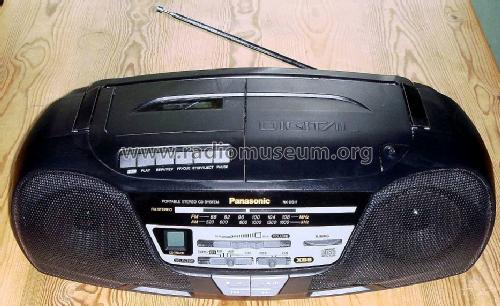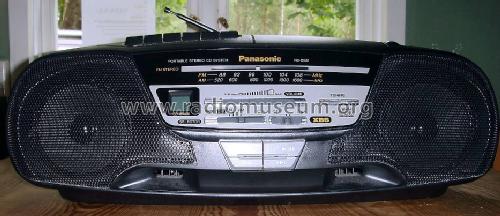RX-DS11 Digit/1L
Panasonic, Matsushita, National ナショナル (also tubes); Osaka
- Country
- Japan
- Manufacturer / Brand
- Panasonic, Matsushita, National ナショナル (also tubes); Osaka
- Year
- 1995 ?
- Category
- Broadcast Receiver - or past WW2 Tuner
- Radiomuseum.org ID
- 118019
- Number of Transistors
- Semiconductors present.
- Semiconductors
- Main principle
- Superheterodyne (common)
- Wave bands
- Broadcast (BC) and FM or UHF.
- Details
- Other Combination - see Notes
- Power type and voltage
- Line / Batteries (any type) / 220 / 6 × 1,5 Volt
- Loudspeaker
- 2 Loudspeakers / Ø 9.5 cm = 3.7 inch
- Material
- Plastics (no bakelite or catalin)
- from Radiomuseum.org
- Model: RX-DS11 Digit/1L - Panasonic, Matsushita,
- Shape
- Portable set > 8 inch (also usable without mains)
- Dimensions (WHD)
- 460 x 140 x 240 mm / 18.1 x 5.5 x 9.4 inch
- Notes
- The Panasonic RX-DS11 is a typical "Ghetto-Blaster-Type" Cassette AND CD-Player-AM-FM-Radio with FM-Stereo. Those "Ghetto-Blasters" have also been called Boombox, Jambox or just "radio-cassette". A boombox is capable of receiving radio stations and playing recorded music (usually cassettes or CDs), usually at relatively high volume. Many models are also capable of recording (onto cassette) from radio and (sometimes) other sources. Designed for portability, most boomboxes can be powered by batteries, as well as by line current. Early Boomboxes were not "roundly" shaped.
Wikipedia 4.Jan 2010: "Boom boxes were introduced commercially by various companies in the late 1970's, when stereo capabilities were added to existing designs of the radio-cassette recorder, which had appeared earlier that decade. More powerful and sophisticated models were subsequently introduced. They are often associated with 1980s phenomena such as breakdancing and hip hop culture, having been introduced into the mainstream consciousness through music videos, movies, television and documentaries. It was during this time that the major manufacturers competed as to who could produce the biggest, loudest, clearest-sounding, bassiest, flashiest and/or most novel boomboxes. As the decade progressed, manufacturers tended to compete more on price (often at the expense of quality), and smaller designs (often designed for simple background listening) became more popular. This era was prior to the introduction and cultural entrenchment of the Walkman style, personal stereos with headphones which would later displace boom boxes in popularity."
- Net weight (2.2 lb = 1 kg)
- 1.7 kg / 3 lb 11.9 oz (3.744 lb)
- Price in first year of sale
- 1,265.00 SEK
- Source of data
- - - Data from my own collection
- Other Models
-
Here you find 3128 models, 2912 with images and 651 with schematics for wireless sets etc. In French: TSF for Télégraphie sans fil.
All listed radios etc. from Panasonic, Matsushita, National ナショナル (also tubes); Osaka


